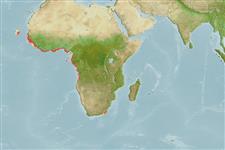Teleostei (teleosts) >
Eupercaria/misc (Various families in series Eupercaria) >
Haemulidae (Grunts) > Haemulinae
Etymology: Pomadasys: Greek, poma, -atos = cover, operculum + Greek, dasys = with hair (Ref. 45335).
Eponymy: Baron Jacques-François Roger (1787–1849) was a jurist, agronomist and colonial administrator who became Governor of Senegal (1821–1827). [...] (Ref. 128868), visit book page.
More on author: Cuvier.
Environment: milieu / climate zone / depth range / distribution range
Ecology
Marine; brackish; benthopelagic; depth range 25 - 90 m (Ref. 27000). Tropical
Eastern Atlantic: west coast of Africa, from Senegal to Angola (Ref. 57395). Also reported from Mauritania (Ref. 5377).
Size / Weight / Age
Maturity: Lm ? range ? - ? cm
Max length : 60.0 cm TL male/unsexed; (Ref. 57395); common length : 45.0 cm TL male/unsexed; (Ref. 2683)
Dorsal spines (total): 12; Dorsal soft rays (total): 15; Anal spines: 3; Anal soft rays: 10. Diagnosis: body oblong and compressed, rather elongate; head profile straight before nape; snout pointed, distinctly longer than eye diameter; 2 anterior pores on chin, followed by a median pit bearing openings of another pair of pores (Ref. 57395). 2nd anal fin spine usually shorter than 3rd (Ref. 57395, 81655). Caudal fin deeply forked; scales ctenoid; 6-7 scale rows between lateral line and middle of spinous dorsal-fin base (Ref. 57395). No pore above posterior end of maxilla and under preorbital bone (Ref. 81655).
Coloration: silvery with small dark spots forming a pattern of wavy lines on back and sides; fins greyish, dorsal black at base; a yellow-golden spot on snout (Ref. 57395).
Inhabits coastal waters (Ref. 2683, 57395) close to the bottom (Ref. 57395). Occasionally enters estuaries (Ref. 2135, 57395) and other brackish water areas (Ref. 57395).
Life cycle and mating behavior
Maturity | Reproduction | Spawning | Eggs | Fecundity | Larvae
Oviparous, distinct pairing during breeding (Ref. 205).
Roux, C., 1990. Haemulidae. p. 783-788. In J.C. Quero, J.C. Hureau, C. Karrer, A. Post and L. Saldanha (eds.) Check-list of the fishes of the eastern tropical Atlantic (CLOFETA). JNICT, Lisbon; SEI, Paris; and UNESCO, Paris. Vol. 2. (Ref. 6946)
IUCN Red List Status (Ref. 130435: Version 2024-2)
Threat to humans
Harmless
Human uses
Fisheries: commercial
Tools
Special reports
Download XML
Internet sources
Estimates based on models
Preferred temperature (Ref.
123201): 18.5 - 25.8, mean 19.9 °C (based on 31 cells).
Phylogenetic diversity index (Ref.
82804): PD
50 = 0.5000 [Uniqueness, from 0.5 = low to 2.0 = high].
Bayesian length-weight: a=0.01318 (0.00701 - 0.02480), b=2.99 (2.83 - 3.15), in cm total length, based on LWR estimates for this species & Genus-body shape (Ref.
93245).
Trophic level (Ref.
69278): 3.6 ±0.50 se; based on food items.
Resilience (Ref.
120179): Medium, minimum population doubling time 1.4 - 4.4 years (Preliminary K or Fecundity.).
Fishing Vulnerability (Ref.
59153): Moderate vulnerability (44 of 100).
Nutrients (Ref.
124155): Calcium = 66.8 [14.7, 131.5] mg/100g; Iron = 0.731 [0.377, 1.420] mg/100g; Protein = 18.2 [16.4, 20.0] %; Omega3 = 0.226 [0.105, 0.399] g/100g; Selenium = 63.4 [33.2, 112.1] μg/100g; VitaminA = 26.9 [11.6, 60.2] μg/100g; Zinc = 1.31 [0.91, 1.88] mg/100g (wet weight);
